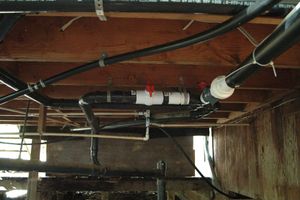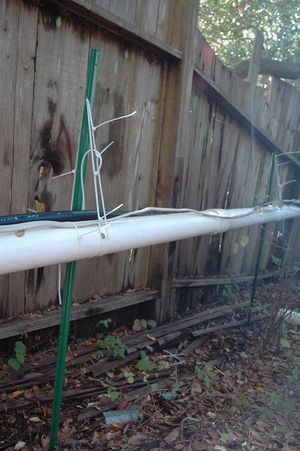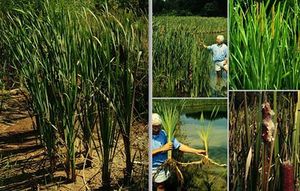Components
Plumbing

The plumbing system is very dependent on your needs and existing plumbing system. Many possibilities exist, such as just capturing the plumbing from the bathroom sink. Another good option for capturing a lot of your water is dual plumbing to capture the greywater but allow for a valve to run greywater to sewer if needed.
Slope

Standards require that any pipe diameter less than or equal to 2” have a slope of 1/4” fall/foot run. And any pipe diameter greater than or equal to 3” have a slope of 1/8” fall/foot run.[verification needed]
Surge tank
The surge tank is some volume to accommodate for high flow, such as times when everyone is showering and washing at once. This is necessary because the back pressure of a subsurface system is relatively high and, therefore, will slow down the flow of water. The piping to the greywater system will provide some surge capacitance, but you risk backing up into the house. You do not want to risk backing up into the house.
Primary treatment
Primary treatment of filtering solids and trapping grease is important in maintaining an efficient subsurface flow, constructed wetland for treating greywater. It is possible to combine the filter, grease trap and settling tank into one system. Each part serves a different purpose and has different maintenance needs.
Filter
- A filter keeps chunks of organic matter out of the constructed wetland by directly filtering it out.
- These organic chunks can clog the wetland, if allowed to enter. In addition they have very a high BOD.
- Filters often need to be cleaned weekly or as needed. Build the filter so that it is easy to remove.
- Greywater Filters
-
Old filter (second generation) from the AEF greywater system. The cloth filtered effectively, but the material did lasted less than one year.
-
Filter (third generation) from the AEF greywater system. The flat metal surface is easy to pick up and clean, but can spill filtered solids.
-
Filter from the Greywater Ecuador La lagrima purificadora system.
-
Filter from the Millcreek greywater system. This depressed metal filter is easy to clean and does not spill easily, but can clog quickly.
Grease trap
- A grease trap keeps grease and fat from getting into the constructed wetland, by providing a barrier to floating material.
- Grease and fat can coat surfaces in the constructed wetland and greatly reduce the treatment capacity of the system, if allowed into the wetland.
- The grease trap should be skimmed weekly or as needed. It will start to look nasty quickly.
Settling tank
- A settling tank allows for smaller particles to settle out before entering the wetland, by providing some time of slow water velocity.
- These smaller particles can slowly clog the entrance of the system, if allowed to pass through the pretreatment.
- The settling tank should be inspected weekly and cleaned every few months or as needed.
- Greywater Combination Grease trap/Setting tanks
-
Grease trap and settling tank from the AEF greywater system. The upside down 5-gallon bucket prevents the grease from passing into the out-to-wetland pipe hidden beneath the bucket. The cut down 55 gallon drum yields some surge protection and retention time for settling.
-
Grease trap and settling tank from the Greywater Ecuador La lagrima purificadora system. The wood has a open gap at the bottom of the tank preventing grease and fat from passing to the second compartment. The 36 gallon brick and cement basin yields some surge protection and retention time for settling.
-
Grease trap and settling tank from the Millcreek greywater system. The small plastic cap provides a barrier to the floating grease and fat from passing into the out pipe. The trash can yields some surge protection and retention time for settling.
Subsurface constructed wetland
Building a subsurface constructed wetland consists of making a volume that is about 1 meter deep, putting in some baffles, filling it with gravel and planting it with wetland plants.
- AEF greywater Subsurface Constructed Wetland
-
Dig a hole
-
Line the hole
-
Put in baffles
-
Fill with gravel and plants
-
Finish planting
-
Diagram of final system
- Greywater Ecuador La lagrima purificadora Subsurface Constructed Wetland
-
Build a pond
-
Build it strong
-
Line the pond
-
Fill with gravel and rock
-
Fill with plants
-
Finish planting
Hole
- The size of your hole should be sufficient to treat the greywater. See System Sizing for more.
Pond liner
- The pond liner protects the groundwater from contamination and may not be necessary in locations with low percolation, clay soils.
Baffles
- The baffles protect the system from short circuiting, i.e. water finding a quick route from the entrance to the outtake.
Gravel
- The gravel makes sure that the system remains subsurface, providing more treatment area (on the surface of the rocks), reducing the attraction to vectors and protecting from accidental contact with humans.
Plants

- The plants should be local wetland plants. Such as:
- Brass Button
- Bulrush
- Broadleaf Cattail
- Common Mare’s-tail
- Common Rush
- Cordgrass
- Duckweed
- Jaumea
- Marsh Pennywort
- Marsh Rosemary
- Pickleweed
- Saltbrush
- Sea-Arrow-grass
- Umbrella sedge
- Water Parsley
- Water Plantain
To find local wetland plants. Seek out low lying wet areas. In dry climates this may be near a factory, business or residence with a semi-constant effluent stream.
Outtake
- Greywater Out Takes
-
Outtake to french drain to bamboo grove at Millcreek greywater
-
Underground outtake to small grove at AEF greywater
-
Outtake box at Greywater Ecuador La lagrima purificadora
System Sizing
Many variables effect the sizing of a constructed wetland greywater treatment system. For instance, high temperatures make for faster processing, high BOD needs longer retention time, surface use of effluent needs longer retention time, etc. Likewise, there are many ways to size a system.





















